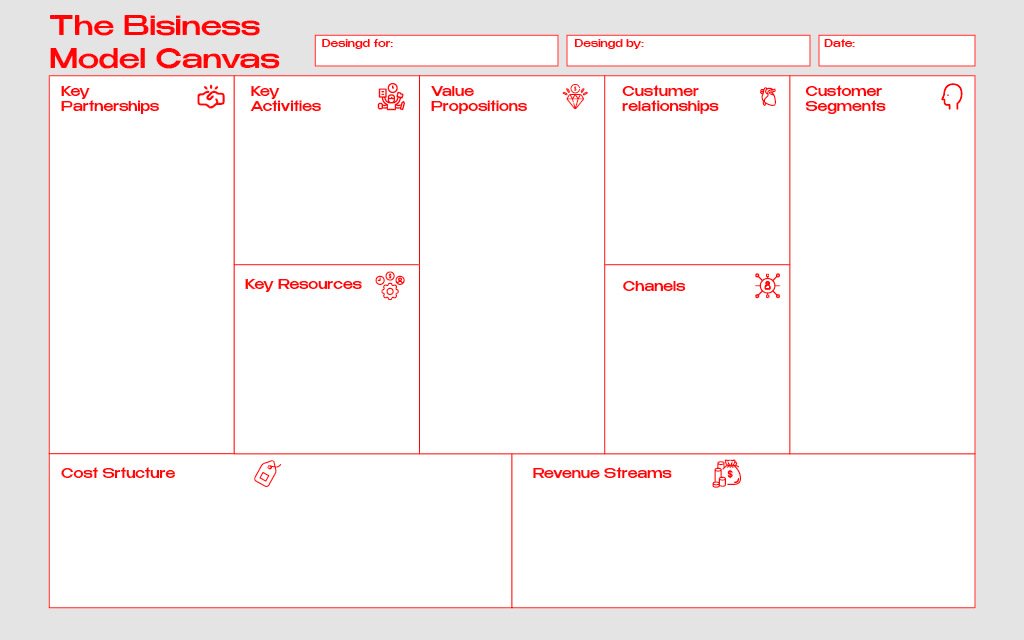At some point in your life, you’ve likely needed to create and develop a business plan, whether as an entrepreneur or while working on a project for a client or your employer. Crafting a business plan can be an interesting challenge, and you may try to include many aspects that might not be ideal, ending up with lengthy and tedious documents. This is why building your business model with a Business Model Canvas allows you to produce a document that is legible, well-crafted, and competitive, bringing much clarity to your business.
What is the Business Model Canvas?
The Business Model Canvas (BMC) is a strategic business tool that helps you conceptualize, present, and visualize your entire business model quickly and efficiently. It is a framework where you can find all the relevant points of your business innovatively and easily.
The Business Model Canvas consists of the following elements:
• Business model: This is your company’s business model, explaining how you will create value and how you will achieve economic and financial benefits.
• Business plan: This is the economic projection expressed in numbers.
• Canvas or Framework: This is the format used to visually present the elements.

What is the Canvas model used for?
Creating your Business Model Canvas will help you discover growth opportunities in your business model. You can identify key partners, discover new ideas, and even plan future actions for your business. The BMC is organized into a matrix of 9 boxes that cover the basic components of your company’s business plan.
The Business Model Canvas was created by Alexander Osterwalder and Yves Pigneur, authors of the book “Business Model Generation,” which has become essential for entrepreneurs worldwide.
What should a Business Model Canvas include?
The business canvas includes 9 boxes, each with relevant elements:
Key Activities
These are tasks that get your business going, the ones that make your business move. They are not your products or services but are the activities that need to be performed for your business to function and progress. Osterwalder suggests you should have three types of activities in this box, and answering the following questions can help identify them:
• What activities are essential to deliver our value proposition?
• What tasks are key to the proper functioning of our distribution channels?
• What activities are crucial in our customer relationships?
• What activities are key to revenue streams?
Key Partners and Associations
Your key partners aren’t necessarily individuals; they can also be associations, companies, or entities that help complement your efforts. It’s important to consider these partners from the start as they are crucial for achieving your objectives.
• Who are our main partners?
• Who are our key suppliers?
• What key resources do we acquire from our partners?
• What key activities do our partners perform?
Key Resources
These refer to the essential resources needed for your business to operate properly, whether they be tools, personnel, financial resources, or technology.
Market Segment or Customers
This refers to the markets you will target: your target market or buyer persona. These are the people to whom you will provide value, who will be your key customers, and why they will choose to buy from you.
Communication Channels
Which communication channels will you use to inform your target market about the value you will provide? This also dictates how you will communicate.
Customer Relationships
Managing your customer relationships is crucial for business growth. Establishing and defining the type of relationship you want with your customers is important for maintaining a stable business and achieving customer loyalty. Here are some questions to consider:
• What kind of relationship does each of our customer segments expect us to establish and maintain with them?
• What relationships have we established?
• How are they integrated with the rest of our business model?
• What are their costs?
Value Proposition or Product
This section might seem simple, but it is actually one of the most complex because you need to clearly explain your product or service. You must identify what is most valuable about your business, what makes your offering unique, and why consumers should choose you over competitors.
Cost Structures
Understanding your cost structure is fundamental; remember, a business that doesn’t generate money isn’t a business. Consider fixed and variable costs, economies of scale, and outsourcing. Here are some questions to help:
• What are the most substantial costs inherent in our business model?
• Which key resources are most expensive?
• Which key activities are most expensive?
Revenue Streams
A robust revenue stream is crucial. You must clearly understand why and what customers will pay for in your business. Here are some questions to help clarify this section:
• What value are our customers truly willing to pay for?
• Why do they currently pay?
• How do they currently pay?
• How would they prefer to pay?
• How much does each revenue stream contribute to the total revenues?
Having a Business Model Canvas for your business not only allows you to start with a clear and effective structure for what you want to achieve but also enables you to quickly view all relevant aspects of your business and may even propel you to new horizons by providing clarity.
Do you already use the Business Model Canvas?
Welcome to the new norm.


